News
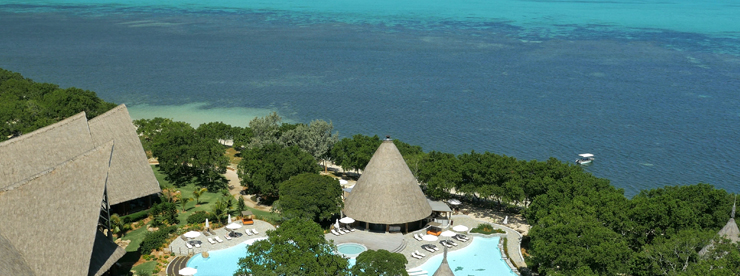
GOLF & Tourism in New Caledonia
New Caledonia gets a world-class golf resort
Right in the heart of the South Pacific, almost 22,000 kilometers (23 hours by air) from mainland France, New Caledonia is hard to escape from the vocabulary of brochures: lush nature, sandy beaches, the varied landscapes of Grande Terre, with its mountain range, cliffs, vast plains and beautiful bays and, above all, the world's largest lagoon, in shades of blue, with its breathtaking flora and fauna.
But New Caledonia isn't just a postcard. This Melanesian land is also an antipodean French territory, rich in the cultures of the peoples who make it up: Kanaks, Caledonians - descendants of the colonists - and newly arrived metropolitans.
In the southern province of New Caledonia, a "very high-end" facility commonly referred to as a tourist resort recently opened in Déva. It includes a 5-star Shératon Hotel, Deep Nature Spa and a top-class 18-hole golf course that now legitimizes New Caledonia as an international tourist destination.
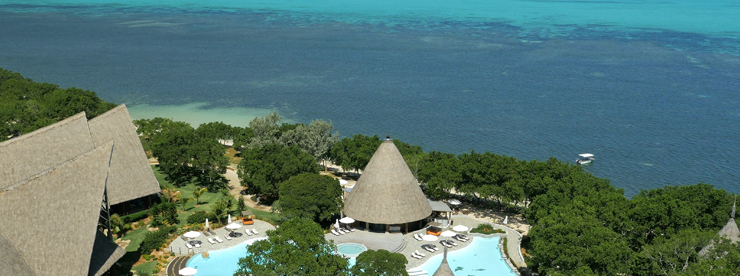
First and foremost, the location chosen for the resort is unique: nestled on the lagoon's west coast, in the middle of a wilderness estate bordered by hills that present a circular, backdrop-style panorama worthy of a Wild West staging. Complementing this tranquil setting, flora and fauna abound, including deer and giant turkey.
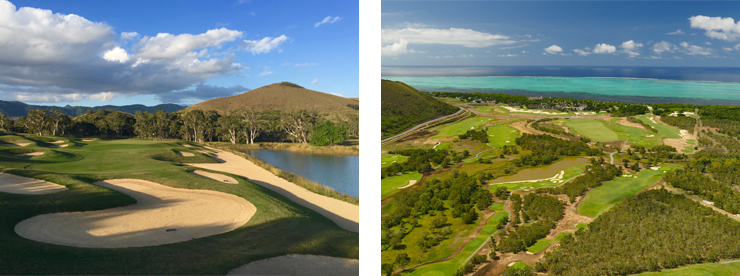
The golf course was designed by Pete Dye's American firm, Dye Designs Group, its first project in Oceania. Dye's design perfectly reflects the site's ecosystem and topography.
The results, in the opinion of the first players, are astounding. "The course is on a par with the best Australian and New Zealand golf courses that New Caledonians play regularly. "
The tees are huge, numbering 4 or 5 depending on the hole, with black balls reserved for professionals.
This multiplicity of tees means that you'll need to choose your bearings carefully, as the tee shots can require considerable ball carrying.
All in all, professionals and players with a 1-digit index will have to contend with a 6,663-metre par 72 course.
The fairways, which are broad and inviting and slightly undulating, wind majestically between the niaoulis, endemic trees that are distant cousins of the eucalyptus. However, beware: the semi-roughs are rather limited, and an off-course ball can quickly become lodged in the undergrowth or in the intense bush rough, resulting in a complicated recovery shot.
Dye's signature is also evident in the number, shape and diversity of the bunkers.
There are 117 bunkers, some of them of a length rarely equalled: over 300 metres of bunker to the left of 9, making you think twice before choosing the axis of play where the golfer will attempt to fly over the beach of this dog-leg left. We find multiple sand obstacles on hole number 14, of various sizes and shapes, then a tree in a bunker to the left of green 15, solitary, majestic, magnificent. But that's not all, on hole 16, two huge bunkers line the right-hand side of this fearsome par 5, 532 meters from the back tees, with a prevailing ¾ face wind. Hole 16 is the start of a formidable finish. Other points of attention on the course are the greens. It's worth noting that all the greens have been sown with paspallum, a grass variety resistant to the warm, iodized climates of the seaside. Other Resort facilities include: A top-of-the-range DEEP NATURE Spa, opened in February 2015 A kids' club for youngsters New Caledonia has three other 18-hole golf courses: Dumbéa, Tina et Ouenghi and Déva. The oldest course is the Garden Golf de Dumbéa (1981). Australian architect: Richard Green It's a parkland-style course, laid out in the middle of a forest of ironwoods, jamelon niaoulis, Maoris, various coconut and palm trees, hibiscus and other trees endemic to the territory. The course meanders along the "Dumbéa" river with long holes, narrow, gently undulating greens, numerous natural obstacles, large, old and beautiful trees and refreshing streams. The 11, a small par 3 with an elevated tee, overlooks the last 9 holes and offers panoramic views of the Koghi and Dzumac mountains. Hole 17 is one of the longest and most difficult par 5s in the Pacific, with its 560 m, dog leg, small lake and river to cross. For a whole decade, the Dumbéa course hosted the New Caledonia International Open (1994 - 2007). The other two courses are : Tina's golf club (1996) Owner and manager: SEM de Tina Networks : Le Club Golf Jean-Luc DUCLOS
There are no fewer than 17 bunkers on par 3 number 11, a real picture-postcard hole, with the green below, bordered on the right by a magnificent water hazard. Time for a selfie.
17, par 3, a signature hole according to Cynthia Dye, Pete's niece who has regularly followed the golf course's construction. Special feature: island green, backing onto the lagoon, with a sea of sand to cross. The distance to the hole is reasonable, 153 meters from the white, but the wind factor will encourage the player to take at least one more rod.
Finally, hole 18 is a par 4 with a fearsome tee shot that requires both length and precision to avoid the banyan trees whose feet are plunged into ... a sea of sand.
They are of standard size, 25 to 30 meters long, 20 meters wide, with numerous slopes and double slopes.
All in all, the Déva course is a breath of fresh air in the midst of typically Caledonian vegetation, providing a sense of well-being and fulfillment, provided you choose your tee-off point wisely!
The high standard of this course already makes it one of the jewels of the Pacific, with an exceptional level of maintenance.
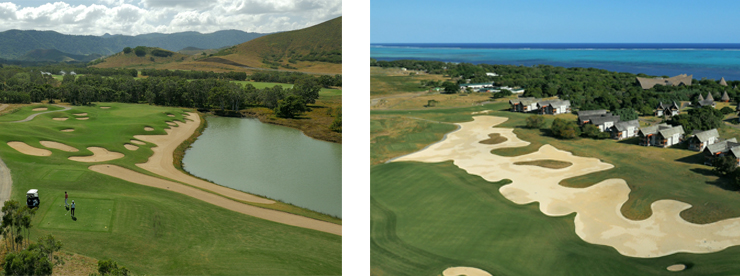
Additional golfing facilities:
- 25-station driving range on grass, with unlimited ball pyramids
- putting green and approach green with 2 bunkers
- 40 state-of-the-art electric golf carts
- Pro Shop in the hotel
- Starter (half way house) near the driving range, tees 1 and 10, greens 9 and 18
- Premium rental club series, graphite and steel, right- and left-handed
Hotel Shératon Déva New Calédonia Resort Golf & Spa:
180 luxurious accommodations including
➢ 60 bungalows built in the style of traditional Melanesian architecture
➢ 40 suites with one-, two- and three-bed options, all with kitchenettes
➢ 80 apartments in 17 2-storey buildings
All rooms feature LED Smart TV, Wifi internet, private terraces, spacious bathrooms with bathtubs and showers
Other main leisure activities include:
The hotel's huge swimming pool, the beach, snorkeling in the lagoon, boat trips, deep-sea fishing, hiking, horseback riding, farm visits, mountain biking, kite surfing, microlighting, etc.
Owner: Mairie de Dumbéa
Manager: Garden Golf de Dumbéa SAS
Networks: UGOLF - Le Club Golf
Manager: Laurent HEUTTE
Les Paillottes de la Ouenghi (1988)
Australian architect: Richard Green
Owner and manager: Dino Sacilotto
This is a rustic-style course with a dozen bungalows, a swimming pool and a restaurant.
Sales manager: Morgan Dufour
This relatively short, undulating course is located in the city of Nouméa, by the sea and mangroves.
The course has hosted 9 editions of the South Pacific Open (2008 - 2016 , Tour Australasia).









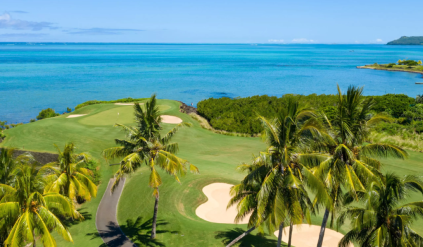
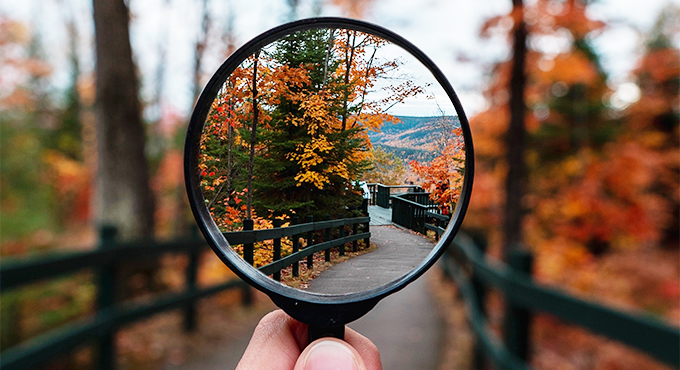


No comment
Log in to post comment. Log in.